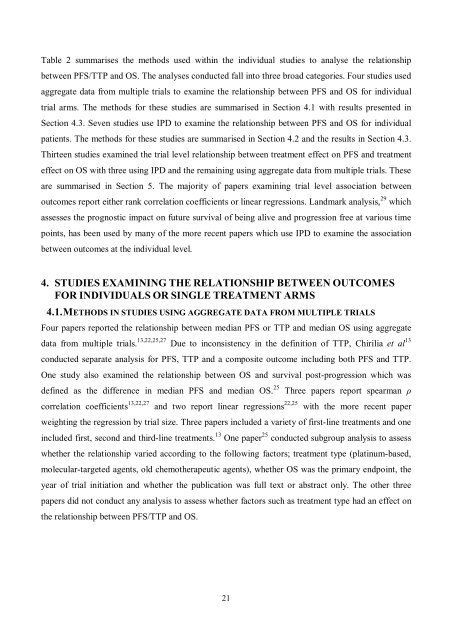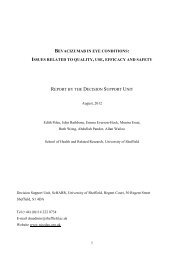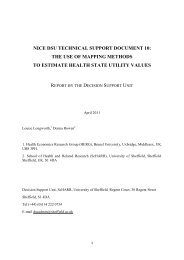A review of studies examining the relationship between progression ...
A review of studies examining the relationship between progression ...
A review of studies examining the relationship between progression ...
Create successful ePaper yourself
Turn your PDF publications into a flip-book with our unique Google optimized e-Paper software.
Table 2 summarises <strong>the</strong> methods used within <strong>the</strong> individual <strong>studies</strong> to analyse <strong>the</strong> <strong>relationship</strong><strong>between</strong> PFS/TTP and OS. The analyses conducted fall into three broad categories. Four <strong>studies</strong> usedaggregate data from multiple trials to examine <strong>the</strong> <strong>relationship</strong> <strong>between</strong> PFS and OS for individualtrial arms. The methods for <strong>the</strong>se <strong>studies</strong> are summarised in Section 4.1 with results presented inSection 4.3. Seven <strong>studies</strong> use IPD to examine <strong>the</strong> <strong>relationship</strong> <strong>between</strong> PFS and OS for individualpatients. The methods for <strong>the</strong>se <strong>studies</strong> are summarised in Section 4.2 and <strong>the</strong> results in Section 4.3.Thirteen <strong>studies</strong> examined <strong>the</strong> trial level <strong>relationship</strong> <strong>between</strong> treatment effect on PFS and treatmenteffect on OS with three using IPD and <strong>the</strong> remaining using aggregate data from multiple trials. Theseare summarised in Section 5. The majority <strong>of</strong> papers <strong>examining</strong> trial level association <strong>between</strong>outcomes report ei<strong>the</strong>r rank correlation coefficients or linear regressions. Landmark analysis, 29 whichassesses <strong>the</strong> prognostic impact on future survival <strong>of</strong> being alive and <strong>progression</strong> free at various timepoints, has been used by many <strong>of</strong> <strong>the</strong> more recent papers which use IPD to examine <strong>the</strong> association<strong>between</strong> outcomes at <strong>the</strong> individual level.4. STUDIES EXAMINING THE RELATIONSHIP BETWEEN OUTCOMESFOR INDIVIDUALS OR SINGLE TREATMENT ARMS4.1. METHODS IN STUDIES USING AGGREGATE DATA FROM MULTIPLE TRIALSFour papers reported <strong>the</strong> <strong>relationship</strong> <strong>between</strong> median PFS or TTP and median OS using aggregatedata from multiple trials. 13,22,25,27 Due to inconsistency in <strong>the</strong> definition <strong>of</strong> TTP, Chirilia et al 13conducted separate analysis for PFS, TTP and a composite outcome including both PFS and TTP.One study also examined <strong>the</strong> <strong>relationship</strong> <strong>between</strong> OS and survival post-<strong>progression</strong> which wasdefined as <strong>the</strong> difference in median PFS and median OS. 25Three papers report spearman ρcorrelation coefficients 13,22,27 and two report linear regressions 22,25 with <strong>the</strong> more recent paperweighting <strong>the</strong> regression by trial size. Three papers included a variety <strong>of</strong> first-line treatments and oneincluded first, second and third-line treatments. 13 One paper 25 conducted subgroup analysis to assesswhe<strong>the</strong>r <strong>the</strong> <strong>relationship</strong> varied according to <strong>the</strong> following factors; treatment type (platinum-based,molecular-targeted agents, old chemo<strong>the</strong>rapeutic agents), whe<strong>the</strong>r OS was <strong>the</strong> primary endpoint, <strong>the</strong>year <strong>of</strong> trial initiation and whe<strong>the</strong>r <strong>the</strong> publication was full text or abstract only. The o<strong>the</strong>r threepapers did not conduct any analysis to assess whe<strong>the</strong>r factors such as treatment type had an effect on<strong>the</strong> <strong>relationship</strong> <strong>between</strong> PFS/TTP and OS.21





